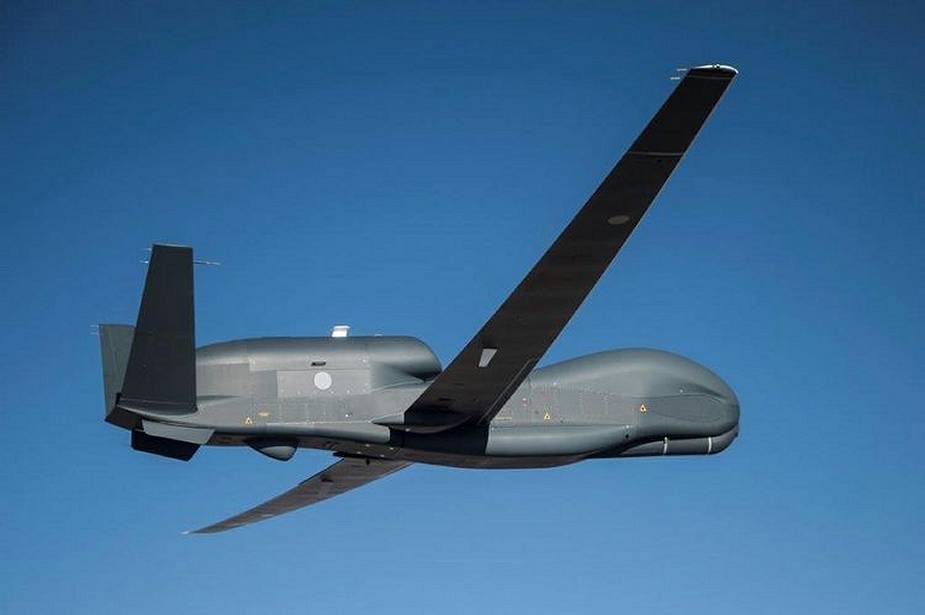According to information published on April 16, 2021, Northrop Grumman Corporation successfully completed the first flight of Japan’s RQ-4B Global Hawk on April 15, 2021, from Palmdale, California. With an unmatched combination of range, endurance, and payload capability, Global Hawk is the only platform that provides greater data collection flexibility than space or medium-altitude assets.
Follow Air Recognition on Google News at this link
 The Northrop Grumman RQ-4 Global Hawk is a high-altitude, remotely-piloted, surveillance aircraft. (Picture source Northrop Grumman)
The Northrop Grumman RQ-4 Global Hawk is a high-altitude, remotely-piloted, surveillance aircraft. (Picture source Northrop Grumman)
“The unarmed RQ-4B Global Hawk will provide Japan with on-demand intelligence, surveillance and reconnaissance information supporting the Japan Air Self-Defense Force’s missions of protecting borders, monitoring threats and providing humanitarian assistance in times of need,” said Jane Bishop, vice president and general manager, autonomous systems, Northrop Grumman. “This successful first flight is a significant milestone in delivering Global Hawk to our Japanese allies.”
Global Hawk is the only high-altitude, long-endurance unmanned air vehicle (UAV) to deliver near real-time on demand data around the clock. Once fielded, Global Hawk will integrate with other Japanese intelligence assets, including ground-based command and control units. The capability will provide solutions to monitor and deter regional threats to ensure Japan has a highly effective national security posture well into the future.
Northrop Grumman’s family of autonomous HALE systems, including Global Hawk, are a critical component of networked, global ISR collection for allied nations and mutual defense organizations around the world. Global Hawk collects ISR data that enables decision-makers to act with the right information at the right time. When Japan’s Global Hawk fleet is fully operational, it will be part of a growing list of allied nations operating high-altitude long-endurance UAVs. The United States, Australia, NATO, and Korea will all be operating versions of this vital national surveillance asset.
Northrop Grumman solves the toughest problems in space, aeronautics, defense and cyberspace to meet the ever-evolving needs of our customers worldwide. Our 97,000 employees define possible every day using science, technology and engineering to create and deliver advanced systems, products and services.
The RQ-4A/B Global Hawk Unmanned Aircraft System (RQ-4A/B Global Hawk) is a high altitude, long-endurance Unmanned Aircraft System (UAS) with an integrated sensor suite and ground segment that provides Intelligence, Surveillance, and Reconnaissance (ISR) capabilities to joint warfighters. The drone is in service with South Korea, Japan, NATO, and United States.
Currently, the RQ-4A/B Global Hawk is available in Block 20, 30, and 40 aircraft which are larger than Block 10 aircraft and capable of carrying up to a 3,000-pound (lb) payload. All Block 10 aircraft have either been retired or transferred to the Navy or National Aeronautics and Space Administration. Block 20 was designed to be Image Intelligence only and carries an Enhanced Integrated Sensor Suite (EISS) that is designed for increased performance range and location accuracy over the Block 10 payload.
The operational Block 20 aircraft have been converted to the Battlefield Airborne Communications Node (BACN) configuration, which provides airborne communications relay and gateway that allows real-time information exchanges between different tactical data link systems and provides decision-makers with critical information.
Block 30 carries the Airborne Signals Intelligence Payload that brings Signals Intelligence capability with the EISS. Block 40 incorporates the Multi-Platform Radar Technology Insertion Program Radar as its only sensor.
















